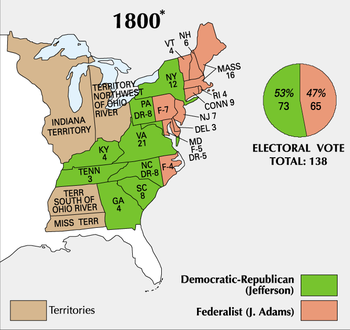U.S. presidential election, 1800
|
|
The U.S. presidential election of 1800 is often considered a realigning election.
The flaws inherent in the original electoral college were brought into full focus in this election. Under the United States Constitution, each presidential elector cast two votes, without distinction as to which was for President or for Vice President. The recipient of a majority of votes was elected President, while the Vice Presidency went to the recipient of the second greatest number of votes.
Though incumbent president John Adams was opposed once again by 1796 opponent Thomas Jefferson, it was Jefferson's running mate, Aaron Burr, who caused the nation's first constitutional crisis. Electors, intending to cast their votes for a Jefferson-Burr ticket, each cast their two votes for Jefferson and Burr, giving each of them 73 votes—a tie.
And while it was common knowledge that Jefferson was the candidate for President and Burr for Vice President, the dominant Federalists were loath to vote for Jefferson, their partisan nemesis. Adding to the situation was that Burr was now a candidate for the Presidency in his own right.
The election went to the United States House of Representatives, which over the course of the next six days cast a total of 35 ballots, with Thomas Jefferson receiving the votes of 8 state delegations each time—one short of the necessary majority of nine. During the confusion, Alexander Hamilton said he supported Jefferson because he was "by far not so dangerous a man" as Burr. Finally, a group of Delaware Federalists led by James A. Bayard reasoned that a peaceful transfer of power would require the majority to choose Jefferson, and on February 17, 1801—just 15 days before inauguration—Thomas Jefferson was elected President on the 36th ballot. Ten state delegations voted for Jefferson and 4 voted for Burr, while two state delegations remained deadlocked.
Jefferson's victory ended America's most acrimonious presidential campaign to date and brought to the forefront a serious constitutional crisis. As a result of the problems arising from the election, and to a lesser extent from the election of 1796, the Twelfth Amendment to the United States Constitution was ratified in 1804, providing that electors make a distinct choice between their selections for President and Vice President.
| Contents |
General election
Results
Jefferson and Burr tied for first place, so the election was thrown into the House of Representatives.
Template:Start U.S. presidential election box Template:U.S. presidential election box row Template:U.S. presidential election box row Template:U.S. presidential election box row Template:U.S. presidential election box row Template:U.S. presidential election box row Template:End U.S. presidential election box (a) The popular vote is not tabulated because (1) only 6 of the 16 states chose electors by any form of popular vote and (2) pre-Twelfth Amendment electoral vote rules obscure the intentions of the voters.
Breakdown by ticket
Template:Start U.S. electoral vote box Template:U.S. electoral vote box row Template:U.S. electoral vote box row Template:U.S. electoral vote box row Template:End U.S. electoral vote box
Contingent election
The members of the House of Representatives balloted as states to determine which of Jefferson and Burr would become President.
Results
| Jefferson | Burr | draw | |
|---|---|---|---|
| 1st – 35th ballots | 8 | 6 | 2 |
| 36th ballot | 10 | 4 | 2 |
| 1st – 35th ballots | 36th ballot | |
|---|---|---|
| Georgia | Jefferson | Jefferson |
| Kentucky | Jefferson | Jefferson |
| New Jersey | Jefferson | Jefferson |
| New York | Jefferson | Jefferson |
| North Carolina | Jefferson | Jefferson |
| Pennsylvania | Jefferson | Jefferson |
| Tennessee | Jefferson | Jefferson |
| Virginia | Jefferson | Jefferson |
| Maryland | draw | Jefferson |
| Vermont | draw | Jefferson |
| Delaware | Burr | draw (a) |
| South Carolina | Burr | draw |
| Connecticut | Burr | Burr |
| Massachusetts | Burr | Burr |
| New Hampshire | Burr | Burr |
| Rhode Island | Burr | Burr |
(a) Delaware had only one representative who cast a blank ballot, giving Delaware a 0 - 0 draw.
Electoral college selection
| Method of choosing Electors | State(s) |
|---|---|
| state is divided into electoral districts, with one Elector chosen per district by the voters of that district | Kentucky Maryland North Carolina |
| each Elector chosen by voters statewide | Rhode Island Virginia |
| Tennessee |
| each Elector appointed by state legislature | (all other states) |
See also
Template:Uspresidentialelections

